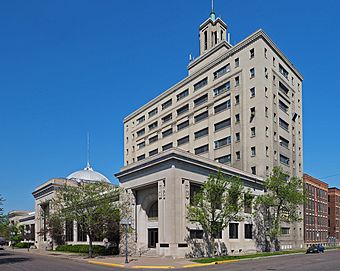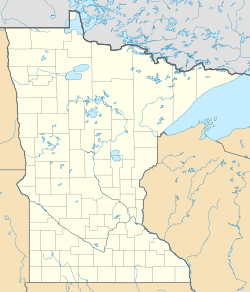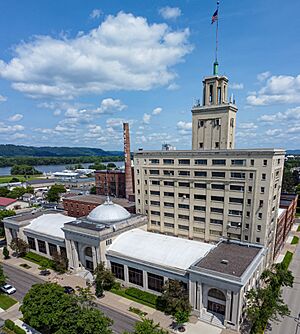Watkins Incorporated facts for kids
Quick facts for kids |
|
|
J. R. Watkins Medical Company Complex
|
|

The J. R. Watkins Headquarters from the southwest
|
|
| Location | 150 Liberty Street, Winona, Minnesota |
|---|---|
| Area | 2.5 acres (1.0 ha) |
| Built | 1900–1914 |
| Architect | George W. Maher |
| Architectural style | Prairie School (1911 Administration Building) |
| NRHP reference No. | 84003940 |
| Added to NRHP | December 4, 2004 |
Watkins Incorporated is a company that makes many different products. These include health remedies, baking ingredients, and other items for your home. The company started in 1868. Its main office is in Winona, Minnesota, in the United States. Watkins sells its products in stores and also through a large group of independent salespeople.
Contents
Company History
How Watkins Began
The company was started by J. R. Watkins in Plainview, Minnesota. He began selling a special kind of medicine called liniment in 1868. He sold it by going door-to-door in southeastern Minnesota.
A year later, J.R. Watkins came up with a clever idea: the "trial-mark bottle." This glass bottle had a special mark on it. Customers could use the product up to that mark. If they weren't happy with it, they could get all their money back. This was one of the first "money-back guarantees" in the United States!
Growing the Business
In 1885, the company moved to Winona. They started making many more products. In 1895, they added baking items like pepper and vanilla extract. They also made cinnamon, ginger, cloves, and other flavor extracts.
Between 1889 and 1914, Watkins built six factories behind their main office building in Winona. J.R. Watkins passed away in 1911. In 1914, a tall ten-story building was finished. This building had a huge dome that was 70 feet high and covered in real 24-carat gold. It also had beautiful stained glass windows.
Watkins During World War II
During World War II, Watkins helped with the war effort. About 90% of their factories made things for the Allied forces. They produced dried eggs, powdered juice, vitamin pills, and even bug sprays like DDT.
Changes Over Time
In the 1940s, Watkins was the biggest direct-sales company in the world. This means they sold products directly to people, often door-to-door. However, over the next few decades, people's shopping habits changed. The company struggled and faced financial trouble in the 1970s.
In 1978, a businessman from Minneapolis named Irwin L. Jacobs bought the company. In 1996, his son, Mark Evan Jacobs, started running the company. Mark had worked as a Watkins salesman for many years. He helped the company by controlling spending and improving how salespeople were paid. He also helped bring Watkins products into regular stores.
Famous Salesman
In 2002, a movie called Door to Door was made about a Watkins salesman named Bill Porter. Bill worked for Watkins for 50 years in Portland, Oregon. He continued his sales route even though he had cerebral palsy. His story was also shared in news reports.
Recent Years
In 2017, the Watkins Company sold some of its product lines. These included home care, personal care, and over-the-counter remedies. A new company, J.R. Watkins Brands, was formed to focus on these products.
In September 2018, Watkins achieved a Guinness World Record. They made the tallest layer cake ever! It was a 6-foot-1-inch Lady Baltimore cake with 260 layers. This beat the old record by 30 layers. The cake used a lot of ingredients, including 900 eggs and 7 pounds of Watkins All Natural Baking Vanilla Extract. This record was set at the Watkins headquarters during the company's 150th anniversary celebration.
Watkins Headquarters
The main Watkins headquarters in Winona is made up of seven buildings. It is listed on the National Register of Historic Places. This means it's an important historical site. In 2004, it was recognized for its importance in architecture, business, and industry. It was the long-time home of the biggest direct sales company in the early 1900s. The 1911 Administration Building was designed in the Prairie School style by architect George W. Maher. The front entrance has a window designed by artist Louis J. Millet. It shows Sugar Loaf, a famous landmark in Winona.
See also





